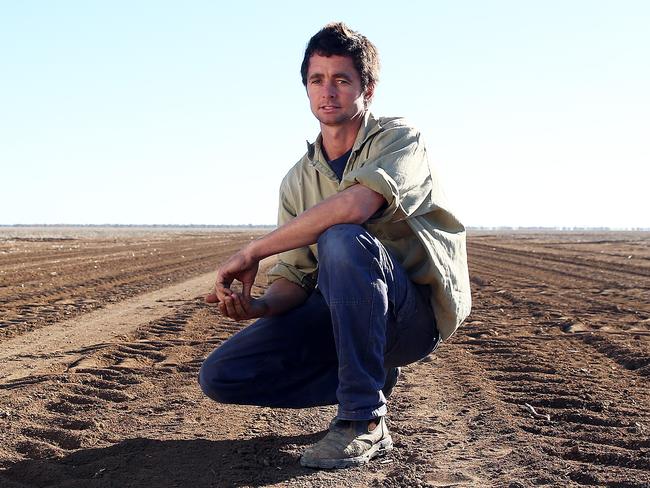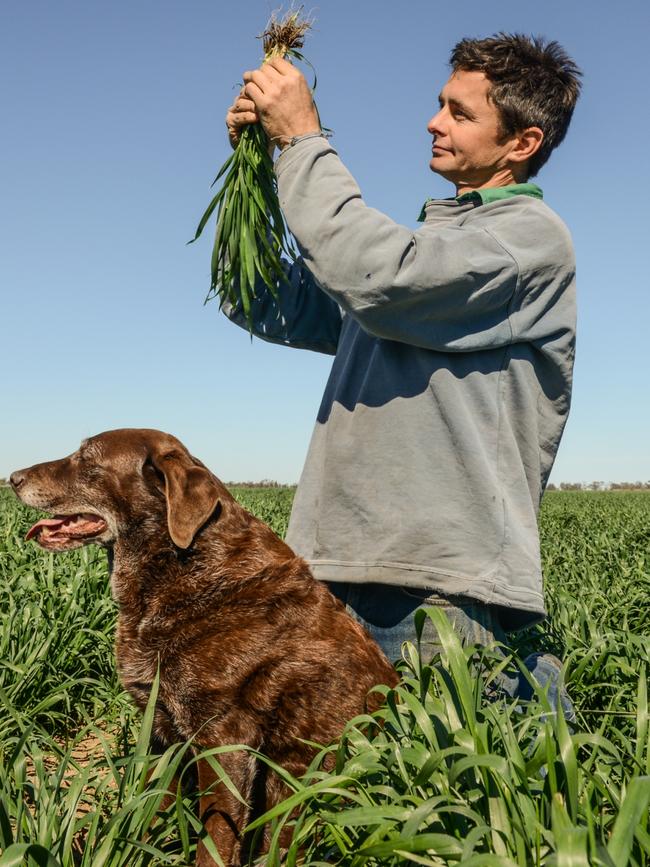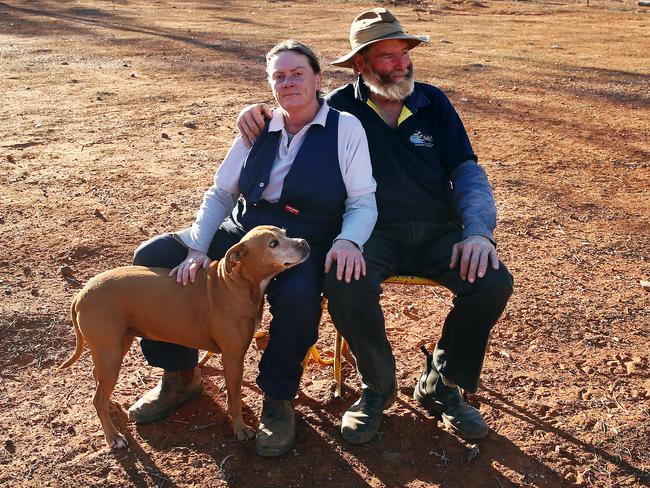Devastating reality as drought continues its destruction in bush
No one in the bush is now immune from the drought. The silos and bank accounts of the state’s wealthiest and most successful farmers have been drained. It has been a year since The Sunday Telegraph launched its Bone Dry campaign. It was bad then, it’s worse now.
NSW
Don't miss out on the headlines from NSW. Followed categories will be added to My News.
No one in the bush is now immune from the drought. The silos and bank accounts of the state’s wealthiest and most successful farmers have been drained.
In Central West NSW, the Buchanan family has been farming their property “Bungle Gully” near Come By Chance since 1931, when they pioneered cropping in the district.
It has never been as dry as it is now.
The vast 100-square-kilometre farm, split between two sites, is on highly fertile low-lying flood country with rich black clay and red loamy soils.
In November 2016, 16 casual workers were run ragged harvesting the farm’s the best ever crop — 9,000 tonnes of chickpeas and 6,500 tonnes of wheat.
After three years of drought between 2013 and 2015, the one-in-100 year crop was sorely needed.
There hasn’t been a crop since.

Charlie Buchanan has earmarked 20 per cent of the farm to sell off if there’s not enough rain by April to grow next year’s crop.
“By November next year, we’ll have reached our debt limit and be back to where we were before 2016,” Mr Buchanan said.
“Everyone else will have to sell too, we’re all in the same position. There won’t be many buyers.”
Of the 350 breeding cattle only 46 remain and of the 600 breeding dorper sheep, there’s only 120 left.
MORE ON THE DROUGHT VIA JACK MORPHET
Top butcher warns lamb could soon be ‘delicacy’ item
For the past two years-and-a-half years, Mr Buchanan has whiled away the days sitting in a tractor guided by a GPS computer that runs up and back barren paddocks spraying weed killer.
For generations, the Buchanans have carefully eradicated weeds but without any crops to compete with and one heavy day of rain in May, all that work would be undone if Mr Buchanan stopped.
“If the weeds went to seed, it would waste years of work,” he said.
“It’s frustrating but you just have to keep busy.”
The farm is so enormous, at the end of an aircraft runway that runs past the homestead is a grain storage shed that looks like it could comfortably house a jet.
A top-of-the-line camera drone flown by The Sunday Telegraph while Mr Buchanan was spraying weeds ran out of battery before it could cover half a paddock.
NSW Farmers president James Jackson said the drought was now hurting even the biggest properties.
“Those big guys are adept at handling drought; they can rely on two or three crops every five years but they’ve only had crop in the last seven years,” Mr Jackson said.
“Regardless of scale, this drought is unprecedented in living memory and you can’t budget for one crop in seven years.
“That’s starting to stress the bank account and their resilience.”


Cheap debt and high commodity prices are keeping farmers afloat but there’s a day of reckoning looming, according to Mr Jackson.
“People are starting to get mortgage distress now, their equity position in their properties is being red-flagged by the banks.
“Because of the royal commission, the banks have been reluctant to foreclose on distressed farmers because it’s bad for their image but there will be foreclosures if the drought keeps going.”
Nine sheep died every day, on average, on grazier James Foster’s property west of Walgett for 86 consecutive days between late February and late May this year.
Across the other side of Walgett, four-year-old Eve Holcombe wanders around the only landscape she’s ever known — her dad’s dessicated, bare dirt farm — nudging and inspecting the bleached rib bones of sheep.
James Foster, 57, and little Eve became the faces of a drought going almost unnoticed in Sydney and the NSW coast when the Sunday Telegraph a year ago revealed a deepening crisis west of the Great Dividing Range.
It was bad then, it’s worse now.

The entries made in the Foster family farm’s work diary last month read “yet more deaths”, “we collect and burn more bodies” and “James burns dead sheep from today”.
“I don’t want anyone to feel sorry for me but this is still our life,” Mr Foster said.
“I know it’s a boring subject, not like a flood or fire, but the drought’s still going and it’s worse than ever.”
Sheep on the 13,300ha property in the State’s north have been handfed a combination of high-protein pellets and hay everyday for seven of the past nine years but they’re not strong enough to handle setbacks such as heatwaves, cold snaps or on rare occasions, a heavy downpour that fills cracks in the dry soil with mud.
An injection of vitamins A, D and E could have saved some sheep, but just as many would likely have died simply walking from the paddocks to the yards for a jab.
More than half of Walgett’s annual rainfall for the year to date fell on May 4 (43.2mm), which grew weeds and native grasses that temporarily stemmed the devastation.
But in the eight weeks since, just 2mm of rain has fallen and the landscape has returned to a barren wasteland, barring the sparse remains of patchy grass typically consigned to the roadside where livestock can’t reach it.


More sheep from the remaining 1,500-strong flock are expected to start dying within “a matter of weeks”.
The past year has been the worst of the couple’s lives, according to Mr Foster’s partner Rachel Tibbey, who carries towels into the paddock every morning to cover the heads of any dying sheep before crows get a chance to peck their eyes out.
“I have been brought to tears every day, but just little lady cries with my hand over my face so James can’t see,” she said.
“This isn’t our first drought, but it’s our worst drought — this is something no one’s ever seen before.”
East of Walgett, fifth generation farmer John Holcombe has been broken by the sixth failed crop in seven years

At four years old his daughter Eve has never seen her home as it has been on a normal year — a sea of vivid green wheat, chickpeas and faba beans six inches high.
Mr Holcombe would gladly sell his home of 31 years and head to the coast if he could fetch market price for his 6,900ha property.
“I’m at the point where I don’t care anymore,” Mr Holcombe said.
“People around here would sell up and leave if we could get a decent price for the land but it’s impossible to sell at the present time.”
A nearby 9,188ha farm worth an estimated $10 million this month passed in at auction when it attracted a paltry $2m bid.
About the only thing which has grown on the Holcombe farm is Eve, who’s noticeably taller than a year ago when the Sunday Telegraph visited the property.



